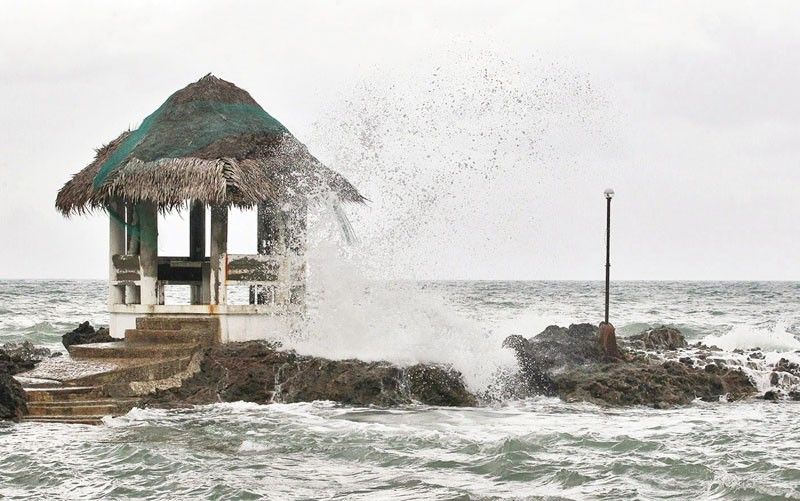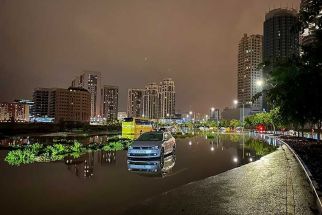Rolly may trigger storm surges, lahar

1 million evacuated as world’s strongest typhoon this year approaches
MANILA, Philippines — Storm surges as high as 10 feet are expected in the country’s east coast as Typhoon Rolly the world’s most powerful this year threatens to unleash its fury on Luzon, including Metro Manila, beginning tonight.
Heavy rains are expected to inundate many parts of Luzon, particularly the Bicol region, and trigger volcanic flow.
“It looks like we will have really strong winds, increasing the chances of widespread flooding and landslides,” Mark Timbal, spokesman for the National Disaster Risk Reduction and Management Council, told ABS-CBN.
“Storm surges are imminent on our east coast. We are monitoring Mayon and Taal volcanos for possible volcanic mud flows,” he added.
Authorities yesterday ramped up preparations in the Bicol region, marshaling rescue vehicles, emergency response teams and relief goods ahead of the typhoon.
“Violent winds and intense rainfall” are expected that could trigger flooding and landslides in the region of more than 20 million people,
according to the Philippine Atmospheric Geophysical and Astronomical Services Administration (PAGASA).
In an advisory released Friday night, the Philippine Institute of Volcanology and Seismology (Phivolcs) said high-volume rainfall is expected to generate volcanic sediment flows or lahar from Mayon, Taal and Pinatubo.
PAGASA said Rolly (international name Goni) will likely remain in the typhoon category as it carries maximum sustained winds of 215 kilometers per hour at the center and gustiness of up to 265 kph.
Tropical cyclone warning signal number 3 was raised in the areas of Catanduanes, the northeastern portion of Camaries Sur and the northeastern portion of Albay.
Signal numbers 3 and 4, the highest alert level, mean that the wind could pose heavy damage to high-risk structures and could cause widespread disruption of electrical power and communication services.
With winds of up to 121-170 kph, large trees could be broken and this will cause widespread damage to agriculture, such as banana, coconuts, corn and rice crops.
‘Super typhoon?’
PAGASA said the typhoon would be considered a super typhoon if it reached maximum sustained winds of at least 220 kph based on the average of 10-minute intervals.
The eye of the typhoon was located 345 km east of Virac, Catanduanes at 4 p.m. yesterday and was moving westward at 25 kph.
It was expected to make landfall in Catanduanes today between 4 and 6 a.m., and then Camarines at around 6 to 8 a.m. It will get to mainland Quezon by afternoon through evening.
Rolly will cross Southern Luzon and Metro Manila as it is forecast to exit the Philippines by tomorrow morning.
Phivolcs, meanwhile, said Rolly could generate post-eruption lahar from Mayon Volcano in Albay and streamflows may occur along Miisi, Binaan, Anoling, Quirangay, Maninila, Masarawag, Muladbucad, Nasisi, Mabinit, Matan-ag and Basud Channels.
For Pinatubo, lahar is likely to flow into the upper to middle reaches of the Sto. Tomas-Marella and Bucao River systems.
It may also send muddy streamflows and floods and affect communities of San Marcelino, San Narciso, San Felipe and Botolan, Zambales, as well as along the O’Donnell and Pasig-Potrero River systems.
Muddy streamflow and muddy runoff around Taal Volcano, particularly on the slopes west of Taal Lake, could affect communities in Agoncillo and Laurel, Batangas.
Rolly is the strongest typhoon to hit the Philippines this year. The deadliest storm on record was Super Typhoon Yolanda (Haiyan), which unleashed giant waves on Tacloban City and left more than 7,300 people dead or missing in 2013.
Authorities ordered yesterday the evacuation of thousands of residents in many parts of Luzon as the category 5 typhoon made its way to land.
1 M evacuated
The National Disaster Risk Reduction Management Council (NDRRMC) said almost a million individuals have been evacuated, mostly in Bicol, ahead of Rolly’s onslaught.
Office of Civil Defense chief Ricardo Jalad said that in Albay alone, an estimated 794,000 individuals were evacuated.
Data from Camarines Sur showed that around 46,000 families or almost 200,000 individuals were also evacuated yesterday.
As for Camarines Norte, specifically for Calaguas islands, about 1,300 families or 6,000 individuals were brought to evacuation centers.
“The strength of this typhoon is no joke,” Gremil Alexis Naz, a local disaster official, told dzBB radio. “Evacuating people is more difficult at this time because of COVID-19.”
Typhoon Quinta last week killed 22 people, mostly through drowning in provinces south of Metro Manila, which is also in the projected path of Typhoon Rolly, the 18th tropical storm to enter the country.
Authorities are facing another hurdle as social distancing needs to be imposed in evacuation centers to prevent the spread of coronavirus. The Philippines has the second highest COVID-19 infections and deaths in Southeast Asia, next only to Indonesia.
Relief goods, heavy machinery and personal protective equipment are already positioned in key areas, Infanta, Quezon Mayor Filipina Grace America told dzBB. “But because of the COVID-19 pandemic, our funds for calamity concerns and expenses are insufficient,” she said.
Local officials cancelled port operations and barred fishers from setting sail.
Another typhoon, Atsani, is gaining strength just outside the Philippines. Around 20 typhoons hit the Philippines every year. It will be given a local name Siony once it enters the Philippine area of responsibility.
Schools, which have been empty since the start of the coronavirus pandemic, will be used as emergency shelters as well as government-run evacuation centers and gymnasiums.
A maximum of five people would be allowed to shelter in a single schoolroom that previously would have held 16, Naz said, adding that the natural disaster-prone region had enough facilities.
Hundreds of people have been left stranded after the coast guard ordered ferries and fishing boats into port in expectation of rough seas throwing up 15-meter waves.
Metro preparations
Metro Manila also went on high alert yesterday. Tarpaulins and billboards were temporarily dismantled to prevent them from being blown away by storm winds, according to Manila Disaster Risk Reduction and Management Office (MDRRMO) director Arnel Angeles.
The local government will also remove tents put up in several barangays, including the tents used in the city’s COVID-19 drive-through serology tests. Rescue boats and outboard motors were also deployed for possible rescue mission, Angeles added.
In Caloocan City, Mayor Oscar Malapitan said he ordered the Christmas displays around the city put away. He also told the Business Permit and Licensing Office to inform business establishments to put down billboards.
Navotas Mayor Toby Tiangco and Valenzuela Mayor Rex Gatchalian halted all construction activities in their cities as they ordered building owners and contractors to secure structures, equipment and devices, and remove tarpaulins, billboards and signages.
In Malabon, Mayor Antolin Oreta III said the city’s waterways had been unclogged to prevent flooding.
The Quezon City local government has also implemented preventive evacuation in landslide-prone and low-lying areas ahead of the arrival of Typhoon Rolly.
Mayor Joy Belmonte convened yesterday the city’s disaster risk reduction and management council as Rolly made its way to land.
The city raised the alert level to yellow and ordered preemptive evacuation in 23 landslide-prone and six low-lying barangays.
Barangays with areas prone to landslide include Bagong Silangan, Bagumbayan, Batasan Hills, Blue Ridge A and B, Commonwealth, Culiat, Escopa 4, Fairview, Holy Spirit, Kaligayahan, Libis, Loyola Heights and Matandang Balara.
Also included were Panson, Pasong Putik, Pasong Tamo, Payatas, Santa Monica, St. Ignatius, Sta. Lucia, Ugong Norte, UP Campus and White Plains.
Six low-lying barangays were Apolonio Samson, Bagong Silangan, Doña Imelda, Marible, Masambong and Roxas.
In an advisory, the city government urged residents in affected areas to cooperate with authorities to ensure zero-casualty in the aftermath of the typhoon. The same preparations were implemented in Makati City and Paranaque City.
Earlier, the QC DRRMC prepositioned its urban search and rescue teams in critical areas such as in barangays along G. Araneta Ave.
The social services department said it would deploy social workers and preposition soup kitchen and relief goods at various evacuation centers.
Trimming of trees will also be conducted along major thoroughfares to avoid accidents.
Belmonte reminded barangay officials to strictly follow health protocols at evacuation centers to ensure the safety of evacuees and frontliners.
“Residents are advised to call our Hotline 122 and we will immediately address your emergency concerns,” she added.
Bulacan Gov. Daniel Fernando also reported launching preventive evacuations of families from river banks and low-lying areas.
Designated as evacuation centers are the provincial gymnasium and the Bulacan Sports Complex.
Francisco Clara, officer-in-charge of the water control and coordinating unit of Bustos Dam, said they began at 7 a.m. a gradual discharge of water from the dam to reduce its water elevation from 15.98 meters to 14.50 meters. – Janvic Mateo, Ramon Efren Lazaro, Ralph Villanueva, Marc Jayson Cayabyab
- Latest
- Trending



























